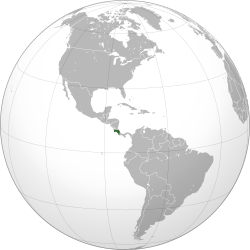Kóstá Rikà
Kóstá Rikà (pípè /ˌkoʊstə ˈrikə/ (![]() listen)), lonibise o je Orile-ede Olominira ile Kosta Rika(Spánì: [Costa Rica] error: {{lang}}: text has italic markup (help) tabi República de Costa Rica, pronounced [reˈpuβlika ðe ˈkosta ˈrika]) je orile-ede ni Arin Amerika, o ni bode mo Nicaragua ni Ariwa, Panama ni ilaorun ati guusu, mo Okun Pasifik ni iwoorun ati guusu ati mo Omi-okun Karibeani ni ilaorun.
listen)), lonibise o je Orile-ede Olominira ile Kosta Rika(Spánì: [Costa Rica] error: {{lang}}: text has italic markup (help) tabi República de Costa Rica, pronounced [reˈpuβlika ðe ˈkosta ˈrika]) je orile-ede ni Arin Amerika, o ni bode mo Nicaragua ni Ariwa, Panama ni ilaorun ati guusu, mo Okun Pasifik ni iwoorun ati guusu ati mo Omi-okun Karibeani ni ilaorun.
Orile-ede Olominira ile Kosta Rika Republic of Costa Rica [República de Costa Rica] error: {{lang}}: text has italic markup (help)
| |
|---|---|
Orin ìyìn: [Noble patria, tu hermosa bandera] error: {{lang}}: text has italic markup (help) (Spanish) Noble homeland, your beautiful flag 1 | |
 | |
| Olùìlú àti ìlú tótóbijùlọ | San José |
| Àwọn èdè ìṣẹ́ọba | Spani |
| Lílò regional languages | Mekatelyu, Bribri |
| Orúkọ aráàlú | Kóstá Rikà |
| Ìjọba | Oseluarailu onilana-igbepapo (Orile-ede Olominira Oniaare) |
• Ààrẹ | Rodrigo Chaves Robles |
| Stephan Brunner | |
| Mary Munive | |
| Aṣòfin | Iléìgbìmọ̀ Aṣòfin |
| Ilominira Filole | |
• latowo Spein | September 15, 1821 |
• latowo Meksiko | October 4, 1824 |
• latowo UPCA | March 21, 1847 |
• Recognized by Spain | May 10, 1850 |
| Ìtóbi | |
• Total | 51,100 km2 (19,700 sq mi) (128th) |
• Omi (%) | 0.7 |
| Alábùgbé | |
• July 2009 estimate | 4,253,897[1] (123rd) |
• Ìdìmọ́ra | 85/km2 (220.1/sq mi) (107th) |
| GDP (PPP) | 2009 estimate |
• Total | $48.881 billion[2] |
• Per capita | $10,579[2] |
| GDP (nominal) | 2009 estimate |
• Total | $29.318 billion[2] |
• Per capita | $6,345[2] |
| Gini (2007) | 48.0[1] Error: Invalid Gini value · 30th |
| HDI (2007) | ▲ 0.854 Error: Invalid HDI value · 54th |
| Owóníná | Costa Rican colón (CRC) |
| Ibi àkókò | UTC-6 (CTZ) |
| Ojúọ̀nà ọkọ́ | otun |
| Àmì tẹlifóònù | +506 |
| Internet TLD | .cr |
Kosta Rika, to tumosi "Eti Odo Olora", ti pa constitutionally ise ologun re re pelu ilana-ibagbepo ni 1949.[3][4][5] Ohun nikan ni orile-ede Amerika Latini to wa ni akojo awon orile-ede 22 oseluarailu pipejulo.[6] Kosta Rika lemolemo ti wa larin awon orile-ede Amerika Latini to gaju nipa Atoka Idagbasoke Eniyan, o si wa ni ipo 54th lagbaye ni odun 2007.[7] O wa ni ipo keta lagbaye, ati akoko ni gbogbo Amerika, nipa Atoka Bi Ayika Se Wa ni 2010.[8]
Ni 2007 ijoba Kosta Rikan sekede eto fun Kosta Rika lati di orile-ede ti ko lo karbon ni 2021.[9][10][11] Gege bi New Economics Foundation se so, Kosta Rika gba ipo kinni ninu Atoka Planeti Adunnu beesi ni o je orile-ede "alawoewe julo" lagbaye.[12]
Itan
àtúnṣeKi Columbus o to wa ibe ri awon omo abinibi ile Kosta Rika je apa were part of the Agbegbe Arin kariaye to budo si awon agbegbe idasa Mesoamerika ati Andes. Eyi ti je siodotun lati kopo ipa agbegbe Isthmo-Colombian. Ibi yi ni awon asa abinibi Mesoamerika ati Guusu Amerika ti pade.
Apa ariwaiwoorun orile-ede yi, Peninsula Nikoya, ni o je ibi guusujulo fun ipa asa Nahuatl nigbati awon olubori ara Spein de be ni orunddun kerindinlogun. Arin ati apaguusu orile-ede ni ipa Chibcha. Sibesibe, awon eniyan atilewa ti kopa lori asa Costa Rican odeoni niye to kere, nitoripe opolopo ninu won ku lowo awon arun bi smallpox[13] ati idamu latowo awon alamusin ara spein.
| Àyọkà yìí tàbí apá rẹ̀ únfẹ́ àtúnṣe sí. Ẹ le fẹ̀ jù báyìí lọ tàbí kí ẹ ṣàtúnṣe rẹ̀ lọ́nà tí yíò mu kúnrẹ́rẹ́. Ẹ ran Wikipedia lọ́wọ́ láti fẹ̀ẹ́ jù báyìí lọ. |
Itokasi
àtúnṣe- ↑ 1.0 1.1 "Costa Rica". CIA The World Factbook. Archived from the original on 2020-05-13. Retrieved 2010-08-03.
- ↑ 2.0 2.1 2.2 2.3 "Costa Rica". International Monetary Fund. Retrieved 2010-04-21.
- ↑ El Espíritu del 48. "Abolición del Ejército" (in Spanish). Retrieved 2008-03-09.
- ↑ "Costa Rica". World Desk Reference. Retrieved 2009-06-09.
- ↑ "Costa Rica". Uppsala Universitet. Retrieved 2009-06-09.[Ìjápọ̀ tí kò ṣiṣẹ́ mọ́]
- ↑ "Costa Rica's new president: Thriller for Chinchilla". The Economist. 2010-02-11. http://www.economist.com/world/americas/displaystory.cfm?story_id=15501885&fsrc=rss. Retrieved 2010-02-16.
- ↑ UNDP Human Development Report 2009. "Table H: Human development index 2007 and its components" (PDF). UNDP. Retrieved 2009-10-05.
- ↑ Yale Center for Environmental Law & Policy / Center for International Earth Science Information Network at Columbia University. "2010 Environmental Performance Index". Archived from the original on 2010-02-04. Retrieved 2010-01-27.
- ↑ John Burnett (2008-02-18). "Costa Rica Aims to Be a Carbon-Neutral Nation". National Public Radio (NPR.org). http://www.npr.org/templates/story/story.php?storyId=19141333. Retrieved 2009-04-27.
- ↑ Alana Herro (2007-03-12). "Costa Rica Aims to Become First "Carbon Neutral" Country". Worldwatch Institute. http://www.worldwatch.org/node/4958. Retrieved 2009-04-27.
- ↑ Alejandro Vargas (2007-02-21). "País quiere ser primera nación con balance neutro de carbono" (in Spanish). La Nación. Archived from the original on 2007-10-11. https://web.archive.org/web/20071011010801/http://www.nacion.com/ln_ee/2007/febrero/21/aldea1002694.html. Retrieved 2009-04-27.
- ↑ Ashley Seager (2008-07-04). "Costa Rica is the world's happiest and greenest country in the world.". London: Guardian.co.uk. http://www.guardian.co.uk/environment/2009/jul/04/costa-rica-happy-planet-index. Retrieved 2009-07-04.
- ↑ "The Story Of... Smallpox". Pbs.org. Retrieved 2010-06-26.

